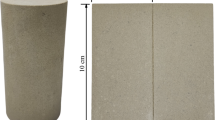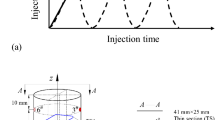Abstract
Fluid substitution plays the key role in reservoir characterization, leading to enhance understanding of the influence of fluids on seismic parameters. In general, fluid substitution tool assumes that the Earth is as an isotropic medium, which may not represent the practical field situation. Nevertheless, anisotropic fluid substitution provides important insights into the processes that control the anisotropic seismic response of a fractured rock when subjected to CO2 injection for enhanced oil recovery and its geological sequestration. Here, we examine the influence of fluid substitution in a porous yet fractured reservoir for quantitative interpretation of seismic data. This investigation involves anisotropic Gassmann’s equation and linear slip theory for fluid substitution in a transversely isotropic media with a horizontal axis of symmetry (HTI). We present a synthetic case by conceptualizing a double-layered half-space model with upper layer as shale and bottom layer as HTI sandstone, representing an Indian mature reservoir. The effects of variation in background porosity and fracture weaknesses on anisotropic (Thomsen’s) parameters, acoustic parameters including amplitude variation with angle have also been discussed. We observe that brine and oil sands to be associated with the highest elastic moduli, while CO2 sands exhibit contrasting trend. It is noteworthy that CO2 is more sensitive to fracture weakness when compared to the other reservoir fluids such as hydrocarbons and brines, as P-wave moduli (as much as 37.1%) and velocity (as high as 12.2%) reduces significantly with the increase in fracture weakness. Further, Gassmann’s assumption is validated as we noticed unchanged values in shear-wave moduli and shear-wave splitting parameter (γ) for various fluid types.





Similar content being viewed by others
References
Batzle M, Wang Z (1992) Seismic properties of pore fluids. Geophysics 57:1396–1408. https://doi.org/10.1190/1.1443207
Biot MA, Willis DG (1957) The elastic coefficients of the theory of consolidation. J Appl Mech 24:594–601. https://doi.org/10.1002/9780470172766.ch13
Brown RJS, Korringa J (1975) On the dependence of the elastic properties of a porous rock on the compressibility of the pore fluid. Geophysics 40:608–616. https://doi.org/10.1190/1.1440551
Budiansky B, O’connell RJ (1976) Elastic moduli of a cracked solid. Int J Solids Struct 12:81–97. https://doi.org/10.1016/0020-7683(76)90044-5
Cardona R (2002) Fluid substitution theories and multicomponent seismic characterization of fractured reservoirs. Ph.D. thesis, Colorado School of Mines
Ganguli SS (2017) Integrated reservoir studies for CO2-enhanced oil recovery and sequestration, 1st edn. Springer, Berlin, p XV, 134. https://doi.org/10.1007/978-3-319-55843-1
Ganguli SS, Vedanti N, Akervoll I, Dimri VP (2016a) Assessing the feasibility of CO2-enhanced oil recovery and storage in mature oil field: a case study from Cambay basin. J Geol Soc India 88:273–280. https://doi.org/10.1007/s12594-016-0490-x
Ganguli SS, Vedanti N, Dimri VP (2016b) 4D reservoir characterization using well log data for feasible CO2-enhanced oil recovery at Ankleshwar, Cambay Basin—a rock physics diagnostic and modeling approach. J Appl Geophys 135:111–121. https://doi.org/10.1016/j.jappgeo.2016.10.007
Ganguli SS, Vedanti N, Akervoll I et al (2017) Investigating CO2-enhanced oil recovery potential for a mature oil field: a case study based on Ankleshwar oil field, Cambay Basin, India. Arab J Geosci 10:124. https://doi.org/10.1007/s12517-017-2940-1
Ganguli SS, Vedanti N, Pandey OP, Dimri VP (2018) Deep thermal regime, temperature induced over-pressured zone and implications for hydrocarbon potential in the Ankleshwar oil field, Cambay basin, India. J Asian Earth Sci 161:93–102. https://doi.org/10.1016/j.jseaes.2018.05.005
Gassmann F (1951) Uber die Elastizitat poroser Medien. Veirteljahrsschrift der Naturforschenden Gesellschaft 96:1–23
Gurevich B (2003) Elastic properties of saturated porous rocks with aligned fractures. J Appl Geophys 54:203–218. https://doi.org/10.1016/j.jappgeo.2002.11.002
Hall SA (2000) Rock fracture characterization and seismic anisotropy: application to ocean bottom seismic data. Ph.D. thesis, University of Leeds
Hall SA, Kendall JM (2000) Constraining the interpretation of AVOA for fracture characterisation. In: Anisotropy 2000: fractures, converted waves, and case studies. SEG, pp 107–144
Huang L, Stewart RR, Sil S, Dyaur N (2015) Fluid substitution effects on seismic anisotropy. J Geophys Res Solid Earth 120:850–863. https://doi.org/10.1002/2014JB011246
Hudson JA (1981) Wave speeds and attenuation of elastic waves in material containing cracks. Geophys J R Astron Soc 64:133–150. https://doi.org/10.1111/j.1365-246X.1981.tb02662.x
Hudson JA (1990) Overall elastic properties of isotropic materials with arbitrary. Geophys J Int 102:465–469. https://doi.org/10.1111/j.1365-246X.1990.tb04478.x
Kuster T, Kuster GT, Toksöz MN (1974) Velocity and attenuation of seismic waves in two-phase media: part I. Theoretical formulations. Geophysics 39:587–606. https://doi.org/10.1190/1.1440450
Mavko G, Bandyopadhyay K (2009) Approximate fluid substitution for vertical velocities in weakly anisotropic VTI rocks. Geophysics 74:D1–D6. https://doi.org/10.1190/1.3026552
Padhi A, Mallick S, Behzadi H, Alvarado V (2014) Efficient modeling of seismic signature of patchy saturation for time lapse monitoring of carbon sequestrated deep saline reservoirs. Appl Energy 114:445–455. https://doi.org/10.1016/j.apenergy.2013.10.016
Schoenberg M, Sayers CM (1995) Seismic anisotropy of fractured rock. Geophysics 60:204–211. https://doi.org/10.1190/1.1443748
Huang L, Stewart RR, Sil, S, Dyaur N (2014) Fluid substitution effects on seismic anisotropy. In: SEG technical program expanded abstracts, vol 64, pp 330–335
Sil S, Sen MK, Gurevich B (2011) Analysis of fluid substitution in a porous and fractured medium. Geophysics 76:WA157–WA166. https://doi.org/10.1190/1.3564954
Smith TM, Sondergeld CH, Rai CS (2003) Gassmann fluid substitutions: a tutorial. Geophysics 68:430–440. https://doi.org/10.1190/1.1567211
Thomsen L (1995) Elastic anisotropy due to aligned cracks in porous rock. Geophys Prospect 43:805–829. https://doi.org/10.1111/j.1365-2478.1995.tb00282.x
Zhang JW, Huang HD, Zhu BH, Liao W (2017) Fluid identification based on P-wave anisotropy dispersion gradient inversion for fractured reservoirs. Acta Geophys 65:1081–1093. https://doi.org/10.1007/s11600-017-0088-8
Acknowledgements
We thank the Editor and the anonymous reviewers for providing fruitful suggestions to improve the quality of the manuscript. Also, we thank the Director, CSIR-NGRI for encouraging to publish this work. SSG would like to thank Dept. of Science & Tech. (DST), Govt. of India, for funding this work through DST Inspire Faculty research Grant (Grant No. DST/INSPIRE/04/2016/000174). VPD thanks Professor Appa Rao Podile, Vice Chancellor, University of Hyderabad for Dr. Homi J. Bhabha Chair Professor at UCESS. Further, we state that there is no conflict of interest.
Author information
Authors and Affiliations
Corresponding author
Rights and permissions
About this article
Cite this article
Ganguli, S.S., Kumar, P. & Dimri, V.P. Seismic anisotropy of a fractured rock during CO2 injection: a feasibility study. Acta Geophys. 67, 141–148 (2019). https://doi.org/10.1007/s11600-019-00246-w
Received:
Accepted:
Published:
Issue Date:
DOI: https://doi.org/10.1007/s11600-019-00246-w




